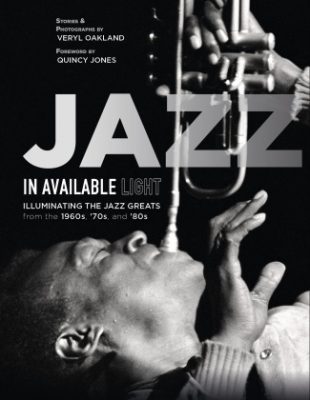.
.
.
…..Jazz in Available Light, Illuminating the Jazz Greats from the 1960s, ’70s, and ’80s is one of the most impressive jazz photo books to be published in a long time. Featuring the brilliant photography of Veryl Oakland — much of which has never been published — it is also loaded with his often remarkable and always entertaining stories of his experience with his subjects.
…..With the gracious consent of Mr. Oakland — an active photojournalist who devoted nearly thirty years in search of the great jazz musicians — Jerry Jazz Musician regularly publishes a series of posts featuring excerpts of the photography and stories/captions found in this important book.
In this edition, Mr. Oakland’s photographs and stories feature Dexter Gordon, Art Farmer and Johnny Griffin.
.
.
All photographs copyright Veryl Oakland. All text excerpted from Jazz in Available Light, Illuminating the Jazz Greats from the 1960s, ’70s, and ’80s
.
You can read Mr. Oakland’s introduction to this series by clicking here
.
.
_____
.
.
© Veryl Oakland
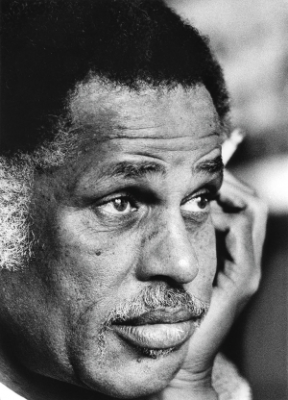
.
Reclaiming What Was Long Overdue
Dexter Gordon
Berkeley, California
.
.
…..He was many things in the jazz hierarchy: the first important bebop tenor saxophonist (the equivalent of Charlie Parker on alto saxophone and Dizzy Gillespie on trumpet); the most celebrated of its many expatriate musicians; and the only individual to receive an Academy Award nomination for Best Actor in a Leading Role.
…..For all of his eminence and notoriety, one would expect Dexter Gordon to be a mover and shaker, an outgoing firebrand, and always on the go. Instead, he was relaxed, laid-back, and generally unflappable.
…..Gordon was blessed with an endless stream of musical ideas that helped propel him through the demanding bebop tempos, and yet became easily recognized for his big sound and signature behind-the-beat playing style.
…..In the early 1960s, after becoming disenchanted with jazz’s free movement and lack of playing opportunities, Dexter moved to Europe. Beginning in 1962, he spent the better part of 14 years across the pond, first living in Paris and finally settling in Copenhagen.
…..Returning to a hero’s welcome in 1976, Gordon basked in an extended period of adulation from fans beginning at the Village Vanguard in New York and later through successful tours around the country. It was at the Berkeley Jazz Festival in May, 1977 – which drew esteemed admirers from many corners – that I saw the leader fronting a solid band featuring trumpeter Woody Shaw, pianist Ronnie Mathews, bassist Stafford James, and drummer Louis Hayes.
….
…..When I met with Dexter for a photo shoot in his Berkeley hotel room, he was just kicking back and enjoying the good vibes along with his sideman, Woody Shaw. Their exuberant, but refined blowing session turned out to be the highlight of that weekend’s festival.
…..During our time together, the friendly and affable tenor saxophonist seemed bemused by all the outpouring of attention he was receiving after having returned stateside. It was like, “Where were all these adoring fans and huge crowds when I needed them back in the sixties?”
…..It wasn’t as if Dexter Gordon had been overlooked during those many years abroad. After all, wherever the icon appeared, he was amply celebrated. But, as he told me, “It’s good to be back and feel the love.”
…..After his long-overdue return to America in 1976, Gordon remained, playing to appreciative crowds wherever he went. Ten years later, the tenorman appeared as the fictional Dale Turner, an American jazz musician living in Paris, in the Bertrand Tavernier film, ‘Round Midnight. The following year, he received the Oscar nomination.
…..The nominee never received the Academy Award for Best Actor. But we all know that Dexter Gordon was indisputably the only contender that year – or perhaps any year – who didn’t need to learn how to act his part.
.
© Veryl Oakland
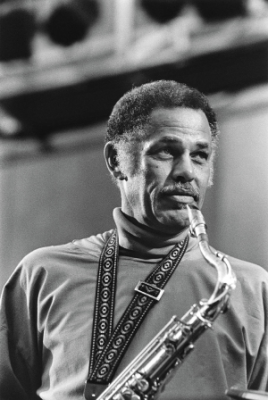
Dexter Keith Gordon
–tenor and soprano saxophones, composer
Born: February 27, 1923
Died: April 25, 1990
.
.
Listen to Dexter Gordon (with, among others, Woody Shaw on trumpet and George Cables on piano) play “The Moontrane,” from the 1977 album Sophisticated Giant
.
.
.
.
_____
.
.
© Veryl Oakland
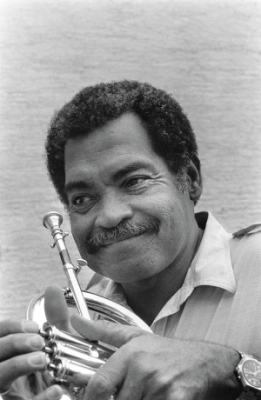
.
Quality Exports (Take 1)
Art Farmer
Vienna, Austria
.
.
…..I had been taken with Art Farmer from the time I first heard him in 1959 with baritone saxophonist Gerry Mulligan’s quartet, and then as co-leader of The Jazztet alongside tenor saxophonist Benny Golson.
…..He wasn’t flashy, or flamboyant. But to me – as a former cornet player myself – Farmer always stood out in any musical group because of his pure, melodiously-constructed solos all projected with a seemingly buttery tone. His performances consistently attained the kind of quality that I could only dream about.
…..Bassist Sam Jones once remarked, “Art Farmer is one of the most lyrical trumpet players in the world. I mean he really knows how to play a melody with feeling.”
…..It was only after spending some time with Art at his home in Vienna that I began to understand the far-reaching impact he had made following a series of tours across Europe on the heels of his early recording successes. What I learned was that his stature here in 1983 was complete: not only did he enjoy a strong bond among fans and concert-goers, but along the way had won the respect and admiration from every type of musician imaginable.
…..Soon after his initial European tours, Farmer discovered there was a much wider audience for his particular sound. In 1968, he was invited to join the Austrian Radio Orchestra, based in Vienna. For the job, he was assured 10 days of work each month, nine months out of the year. Later, he would even be featured as guest soloist with various orchestras, including the Austrian-Hungarian Haydn Philharmonic Orchestra.
…..On the strength of that contract, Art was convinced that his unique brand would provide plenty of work on the continent. He decided that Vienna would become his home base.
…..Once established, Farmer found out pretty quickly that, as he told me, “word travels.” Soon he had assembled a group of quality jazz musicians and began filling in his open calendar dates. Three or four times a year, the Art Farmer Quintet would tour France, Germany, Italy, Switzerland, Liechtenstein, as well as the rest of Austria. When it was time to leave for recording dates and tours of the US and Japan, his sidemen returned to their other musical activities. For example, Art’s fine pianist at the time, Fritz Pauer, served as director of the Swiss Jazz School in Bern, Switzerland.
…..I met Art, his wife Mechtilde – who worked as a local banker – and their 11-year-old son Georg in their home at 40 Durwaringstrasse, a delightful place on a long cul-de-sac near the Vienna Woods.
…..It became quickly understandable why the Farmers decided to call Vienna “home.” Mechtilde’s mother, two brothers, sister, two nieces, and three nephews all resided there. Art, who enjoyed a certain degree of notoriety and recognition among the citizenry, also found the grandeur and Old World charm of the Austrian capital to his liking.
…..During our visit, Art showed me around his home, a retreat perfectly suited for someone of his creative talents. He had two favorite rooms – one for serious business, the other for relaxation and unwinding.
…..Whenever he had a break in his schedule and returned home, Art kept his chops in shape by following a set regimen of “heavy-duty workouts,” practicing for long hours in his specially designed basement room. Farmer’s soundproof music den was actually a room constructed within the confines of another original space. Specially-fitted acoustic windows permitted natural lighting, and all the walls and ceiling were finished in thick foam padding. A separate telephone ringing attachment was installed to alert him when there was an important incoming call.
…..When it was time to just settle back and take it easy, Art would inevitably retreat to his European sauna room constructed by the well-known German manufacturer, Klafs.
…..When I asked about booking local club gigs during his trips home, Art had a quick answer. “It’s the same problem wherever you live,” he told me. “If you make yourself available too frequently for concerts and club dates in your own home town – no matter how popular and established you are – pretty soon the audiences wear away to nothing. The people figure, ‘Why should I pay to see him. I can catch that act anytime.’”
…..While we were still at his home, I photographed Art tending to his mini-garden in the backyard, playing roughly with his Hungarian sheep dog, Aszu, and instructing son Georg on the piano. Afterwards, we all went out for an ice cream treat and a walk through Vienna’s City Park.
…..Before wrapping up, Art grabbed hold of me and we headed off to a busier area of the grounds.
…..I had no idea where he was taking me, as we walked through an area filled with visitors and vacationers. All of a sudden he stopped, unpacked his horn, strolled up a hill and climbed onto the base of a statue to pose next to the famous composer, Johann Strauss II.
…..Every once in awhile, thinking back on that day, I have this crazy scenario in which Johann Strauss is transported forward to the present, joining forces with Art Farmer. Can you imagine how terrific those waltzes would sound?
.
© Veryl Oakland
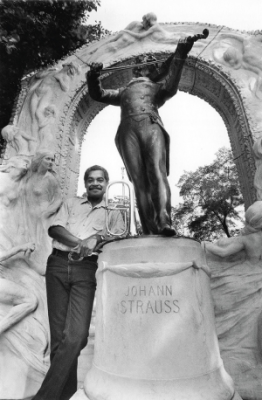
Art Farmer at the commemorative statue of the “Waltz King,” composer Johann Strauss II, or Johann Strauss, Jr; Vienna, Austria
.
Arthur Stewart (Art) Farmer
– flügelhorn, trumpet, composer
Born: August 21, 1928
Died: October 4, 1999
.
.
Listen to a 1982 recording of Art Farmer play “Moose the Mooche,” with Fred Hersch (piano), Ray Drummond (bass), and Akira Tana (drums)
.
.
.
_____
.
.
.
.
© Veryl Oakland
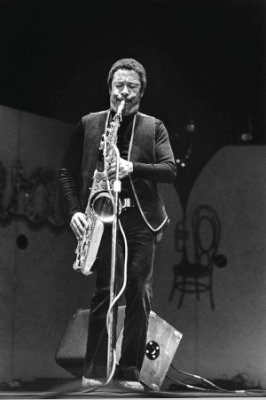
.
Not In the Slightest
Johnny Griffin
Monterey, California
.
.
…..Physically unimposing, the man stood 5’3” and weighed barely 100 pounds.
…..If you didn’t know that, and had never experienced this hard-driving, hard bop tenor saxophonist in person, you wouldn’t have a clue why he was affectionately known as “Little Giant.”
…..It was through listening to his recordings from the 1950s and ‘60s that I became an instant fan and permanent admirer of Johnny Griffin. As a key frontline standout for Art Blakey’s Jazz Messengers, and later, the mercurial cog for the Thelonious Monk Quartet following the departure of John Coltrane, I was especially amazed by his consistently inventive solos spanning a multitude of choruses, all combined with such flawless, incredible speed.
…..I could never quite get enough of his 1958 live performance on Riverside Records at New York’s Five Spot Cafe (Misterioso: Thelonious Monk Quartet), most particularly his scintillating, four-minute solo extravaganza on Monk’s “Evidence.”
…..With the advent of the free movement and its changing jazz styles – funk, jazz-rock, fusion – Griffin’s playing opportunities began to dry up. The tenorman pulled up stakes and moved to Europe. Just like so many others before him, I thought I’d probably never get the opportunity to catch the expatriate live.
…..But then in 1979, after 15 years abroad, I learned about the surprise homecoming. Johnny Griffin was not only returning to America, but would also appear in California. I immediately confirmed my plans and booked reservations.
…..Griffin’s artistic triumph began at Carnegie Hall in New York and continued with a resounding west coast tour. Offering an exhilarating set at the Monterey Jazz Festival, he was overwhelmed by the crowd’s reaction and outpouring of support.
…..The next day, while still greeting and glad-handing his many new-found fans, Johnny was packing up to leave the festival grounds. I caught up with him for a quick photo shoot. It was only some time later, while reviewing those images, that it hit me. I had captured what I had set out to do…present Johnny Griffin as the true giant he was.
…..Recalling that memorable weekend, I think to myself…Johnny Griffin was slight. And none of that mattered in the slightest.
.
© Veryl Oakland
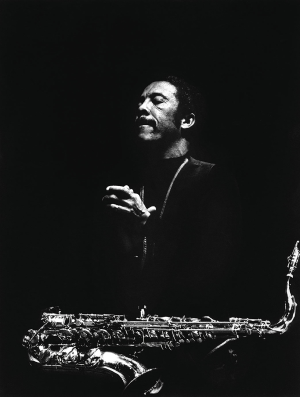
John Arnold III (Johnny, Little Giant) Griffin
– tenor saxophone, composer
Born: April 24, 1928
Died: July 25, 2008
.
.
Listen to Thelonious Monk play “Evidence,” a 1958 recording featuring Johnny Griffin on tenor saxophone
.
.
.
_____
.
.
.
Click here to read the edition featuring Stan Getz, Sun Ra and Carla Bley
Click here to read the edition featuring Art Pepper, Pat Martino and Joe Williams
Click here to read the edition featuring Yusef Lateef and Chet Baker
Click here to read the edition featuring Mal Waldron, Jackie McLean and Joe Henderson
Click here to read the edition featuring Dexter Gordon, Art Farmer and Johnny Griffin.
Click here to read the edition featuring Thelonious Monk, Paul Bley and Cecil Taylor
.
Click here to read the edition featuring drummers Jo Jones, Art Blakey and Elvin Jones
Click here to read the edition featuring Monk Montgomery and the jazz musicians of Las Vegas
Click here to read the edition featuring Sarah Vaughan and Better Carter
.
.
All photographs copyright Veryl Oakland. All text and photographs excerpted with author’s permission from Jazz in Available Light, Illuminating the Jazz Greats from the 1960s, ’70s, and ’80s
.
You can read Mr. Oakland’s introduction to this series by clicking here
Visit his web page and Instagram
.
.




